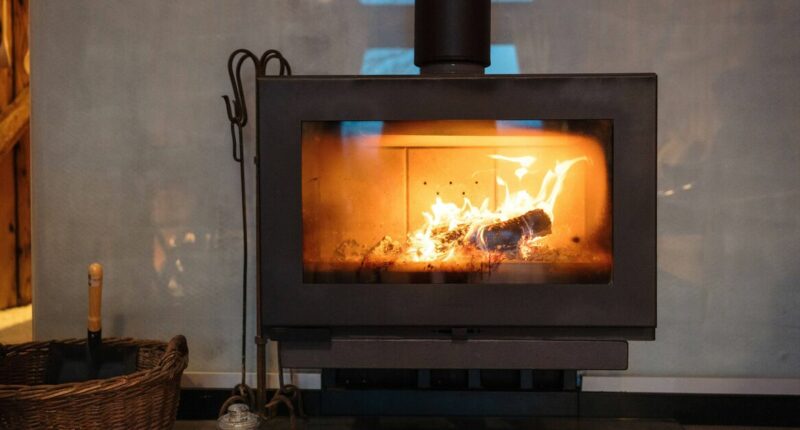Share this @internewscast.com
A stark alert has been sounded for individuals using wood burners and coal fires at home, following a recent study that attributes nearly 2,500 deaths in the UK last year to these heating methods. The report further associates this harmful air pollution with approximately 3,700 diabetes cases and 1,500 instances of asthma annually.
Wood-burning stoves and open fireplaces are significant emitters of fine particulate matter, contributing to cardiovascular and respiratory illnesses. Their popularity has risen in recent times. While the study assessed the potential benefits of broadening and strictly enforcing current smoke control legislation, findings suggest this would only avert about 320 deaths each year and reduce healthcare expenses by an estimated £11 million.
In the past year, local authorities have documented 15,000 grievances concerning wood burning, yet a mere 24 fines have been issued, according to recent research.
Another investigation released this month indicates that indoor wood burning may inflict harm akin to cigarette smoke, connecting the increasing domestic wood burning trend to lung injury. Researchers from University College London examined health data from 11,000 participants involved in the English Longitudinal Study Of Ageing, alongside energy performance certificates (EPCs) at the property level and UK census information.
The Guardian highlighted statements from Larissa Lockwood of Global Action Plan, a charity that initiated the research in cooperation with Hertfordshire County Council. Lockwood stated, “While everyone needs to keep warm this winter, using an open fire or wood-burning stove is the most polluting option for heating a home.” She emphasized, “Air pollution from wood-burning stoves is prematurely claiming lives and causing hospital admissions – the impact on public health in Britain is too substantial to overlook.”
Lockwood urged the government to enhance the authority of local councils and provide clear public guidelines.
Dr Abi Whitehouse, a children’s respiratory specialist working in East London, cautioned: “The smoke and fine particles released by wood-burning stoves can worsen asthma symptoms, trigger attacks, and contribute to long-term respiratory issues, consequences that are entirely preventable with cleaner heating choices. It’s not just our own homes that will be impacted, but the air that makes it into the homes of our neighbours as well.”
A study conducted by top environmental consultancy Ricardo is expected to underestimate the health damage inflicted as it relies on outdoor air pollution levels from solid fuel-burning.
“The exposure impact indoors is likely to be significantly higher, increasing ill-health potential,” the report revealed. “There is no safe level of air pollution,” the report added.
“Fine particulate matter released during combustion has the ability to penetrate deep into the lungs and bloodstream, affecting every organ in the body.”
University College London researchers revealed that domestic wood burning represents one of Britain’s largest individual sources of PM2.5 pollution – microscopic particles which infiltrate deep into lung tissue.
The study discovered that wood-burning devices are predominantly utilised by white residents in wealthy urban areas, including within Smoke Control Zones, according to findings presented at the European Respiratory Society Congress in Amsterdam.
Lung capacity assessments were conducted three times across an eight-year timeframe amongst a smaller cohort of over 1,700 participants.
Scientists employed a measurement to determine how much air individuals could exhale within one second following a deep inhalation, termed forced expiratory volume in one second or FEV1.
The research revealed that FEV1 reductions were more pronounced amongst individuals who operated indoor wood burners.
Amongst study participants aged between 70 and 79, their FEV1 declined by an average of 0.12 litres for those using solid fuels such as indoor wood burners, whilst those without exposure experienced a decrease of just 0.07 litres. The research team discovered that the use of wood as fuel, as reported by individuals, rose from 10% in 2004/05 to 18% in 2021/22.
Dr Horsfall informed the Congress: “We know wood burning at home emits harmful air pollution both indoors and outdoors including known carcinogens.
“Despite this, air pollution from this source has approximately doubled in the UK since 2009 as more people install and use wood stoves.
“However, the link with health outcomes in high-income countries is not well understood and residential areas with high emissions are hard to identify using existing air quality monitoring networks.”
Sarah Sleet, chief executive at Asthma and Lung UK, commented: “The findings of this research aren’t surprising, but do help to add to the body of evidence of the impact of air pollution from wood burners on our lungs. It’s concerning that the numbers of homes with a wood burner is increasing and primarily the reason for having a wood burner is the aesthetic of it.
“Hopefully this research causes people to question if the payoff of having a wood burner is worth it, for the detrimental impact it could have on you and your family’s lungs. It would be good to see increased awareness on the impact of wood burners, with clearer information and guidance from the Government on the health impact, as well as increased regulation around domestic wood burning.”
Professor Ane Johannessen, head of the European Respiratory Society’s expert group on epidemiology and environment, warned: “These findings suggest that wood burners used in European homes may have similar effects and should be considered a potential environmental risk factor when assessing respiratory health, especially in patients with unexplained lung function decline or chronic respiratory symptoms.
“Although new eco-design European wood-burners are generally considered cleaner and safer than more traditional wood stoves, many European homes still employ older wood burners, and even the newer stoves may not be entirely risk-free.
“This study underscores the need for clearer public health guidance and regulation around domestic wood burning.
“People should be aware that these stoves could be harming them and their families, and doctors should be asking their patients about whether they are using stoves at home.”
















